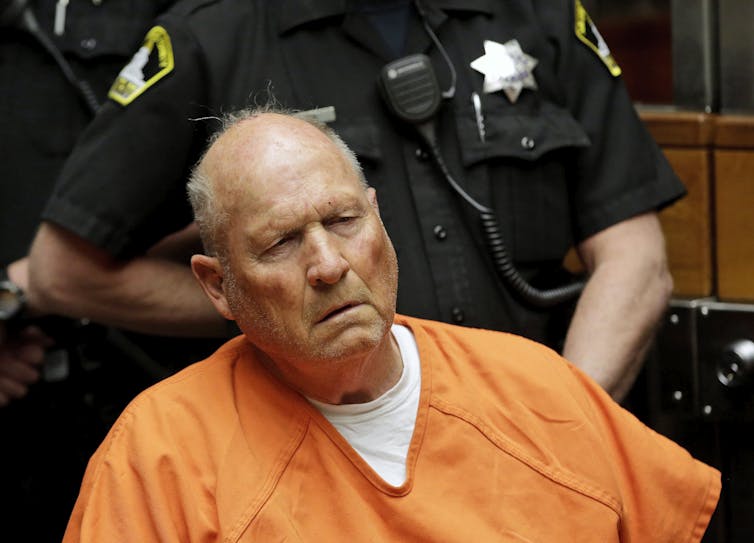The preferred jobs of serial killers: aircraft machinist, arborist, general labourer and cop
Occupations and serial murders are often linked, and some specific full-time and part-time jobs are strangely over-represented among serial killers—so much so that over the last 50 years dominant patterns have begun to emerge
Share

Michael Arntfield is an associate professor of criminology and English literature at Western University
The recent and startling arrest of the elusive Golden State Killer, aka the East Area Rapist/Original Night Stalker/Diamond Knot Killer/Visalia Ransacker in what was arguably the most vexing and disturbing constellation of interlinked cold cases in American history, has raised more questions than answers.
One question is how a serial burglar, rapist and murderer could operate in so many jurisdictions simultaneously and, much like the case of Paul Bernardo in Canada, have law enforcement officials so myopically overlook the connections among his crimes in several different cities.
Another question is, of course, how a police officer like Joseph DeAngelo, the accused Golden State Killer who makes his next court appearance on May 14, could be capable of such sadistic brutality throughout a large portion of his brief and troubled law enforcement career.
Similar questions have been raised in the past about other serial offenders, killers whose innocuous and even virtuous jobs seemed to belie the horrors they committed while hiding behind a veneer of respectability. That includes the infamous Canadian Col. Russell Williams (who once piloted a VIP aircraft whose passengers included Queen Elizabeth) to lesser-known computer store owner and prominent Nashville businessman Tom Steeples, who killed three people for thrills before committing suicide while in police custody.
But in fact, occupations and serial murders are often linked, and some specific full-time and part-time jobs are strangely over-represented among serial killers. So much so, in fact, that over the last 50 years, some dominant patterns have emerged.
As detailed in my recent book, Murder in Plain English, these same occupations are commonly broken down into four categories based on skill, training and turnover. Some of them might surprise you, others not.
Serial killer job breakdown
Top 3 Skilled Serial-Killer Occupations:
1. Aircraft machinist/assembler
2. Shoemaker/repair person
3. Automobile upholsterer
Top 3 Semi-Skilled Serial Killer Occupations:
1. Forestry worker/arborist
2. Truck driver
3. Warehouse manager
Top 3 Unskilled Serial Killer Occupations:
1. General labourer (mover, landscaper, et. al.)
2. Hotel porter
3. Gas station attendant
Top 3 Professional/Government Serial Killer Occupations:
1. Police/security official
2. Military personnel
3. Religious official
Obviously, not everyone occupying these jobs is a serial killer, nor are they likely to become one.
But there’s something about these jobs that is inherently appealing to offenders, or that otherwise cultivates the impulses of serial killers-in-waiting and causes them to be curiously over-represented among this rare breed of murderer.
DeAngelo, the alleged Golden State Killer, for instance, actually held down three of these jobs over the course of his lifetime: Police officer, military personnel (he was previously in the U.S. navy), and, peripherally, truck driver, although his post-police career (he was fired in 1979 for shoplifting) was spent mostly as a mechanic for a fleet of grocery store freezer trucks.
Bygone era
A closer look at the these occupations reveals a bygone era in terms of available jobs — occupations that, while once common and accessible to killers in the ‘60s, ’70s and ’80s —are now largely obsolete. The job market is changing; with that, so is the disturbing but legitimate nexus between murder and labour.
The shift toward a service-based, tech-driven and typically contractual economy, what is often called precarious work, along with the disappearance of once traditional career paths will obviously have profound effects not only on the jobs held by offenders but also how they acquire their victims.
As discussed in my forthcoming book, Monster City, there was a precipitous surge in serial murder in Nashville with the rise of the “new” country music scene in the ’80s and ’90s, giving would-be killers access to new victims.
Serial killers once used the guise of their employment to stalk and acquire specific victims or types of victims (Dennis Rader, Roger Kibbe and Bruce Mendenhall all immediately come to mind). But new research suggests that leisure activities like music, including online interactions, may be the new avenue through which serial killers troll for their victims.
It’s also where they mentally rehearse their crimes amid a shrinking offline public sphere and work world.

The result is that we are likely to see, returning once again to alleged Toronto serial killer Bruce McArthur, blurred occupational-recreational categories involving both online and offline dimensions — a new paradigm that will force us to adjust the list of the most common jobs among serial killers.
The caveat, of course, is that a single defining occupation is in continuous flux. Could “occupation,” for instance, denote a primary vocation, a part-time avocation or even just a paid hobby or pastime?
Pastimes as well as professions?
Might it also include an unpaid pastime by which a person defines himself or herself?
A quick perusal of top LinkedIn “influencers” and “open networkers,” for example, suggests many people actually list their passions or pastimes and not their paid jobs as their primary occupation.
In McArthur’s case, we see that while he conforms to the “general labourer” category, as a landscaper and not just a grass-cutter, as well as the owner of his own company, he also fits no clear vocational definition.
And yet, as we already know from the morbid mass grave recovered from a client’s home on Mallory Crescent in Toronto, the occupation of the accused was central to his alleged offences and how he reportedly disposed of victims — it was integral to his apparent modus operandi.
So while many killers use their employment as a pretext to acquire vulnerable victims, obtain information or cultivate violent fantasies for reasons we still don’t fully understand (“Milwaukee Cannibal” Jeffrey Dahmer once admitted that his work as a chocolate factory machinist awakened homicidal and necrophilic urges he had otherwise suppressed), in McArthur’s case, occupation was the back-end to his alleged crimes, not the inspiration for them.
What about the psychopaths?
As we begin to redraw the map of serial murder and career paths, it might also be useful to look at the otherwise better-known index of occupations over-represented among psychopaths.
While not all psychopaths are serial killers, psychopathy — or at the very least, the possession of psychopathic traits — is a common denominator among serial killers, sex offenders and most violent criminals. Have a look at the Top 10 occupations according to an Oxford University psychologist:
- CEO or business executive
- Lawyer
- Media personality
- Salesperson
- Surgeon
- Journalist or news anchor
- Police officer
- Religious official
- Chef
- Miscellaneous civil servant (military, city council, corrections, etc.)
![]() In overlaying the two lists, we can see that even amid a perpetually changing economy, certain jobs are always likely to appeal to those people we will later be stunned to learn managed to carry on that type of work while also being monsters in our midst.
In overlaying the two lists, we can see that even amid a perpetually changing economy, certain jobs are always likely to appeal to those people we will later be stunned to learn managed to carry on that type of work while also being monsters in our midst.
Michael Arntfield, Associate Professor of Criminology & English Literature, Western University This article was originally published on The Conversation. Read the original article.
Correction, June 12, 2018: This post originally described Bruce McArthur as a landscape architect. Because the alleged serial killer was never a card-carrying member of the Ontario Association of Landscape Architects, he could not have used the job description—protected by law as of 1984—of “landscape architect.” This post now reflects a more accurate title: “landscaper.”